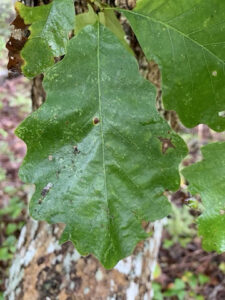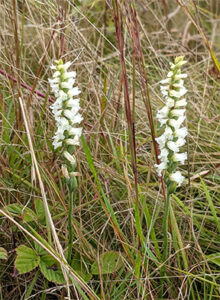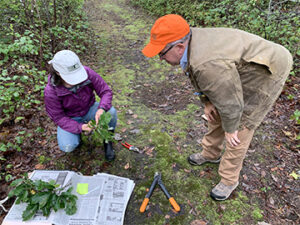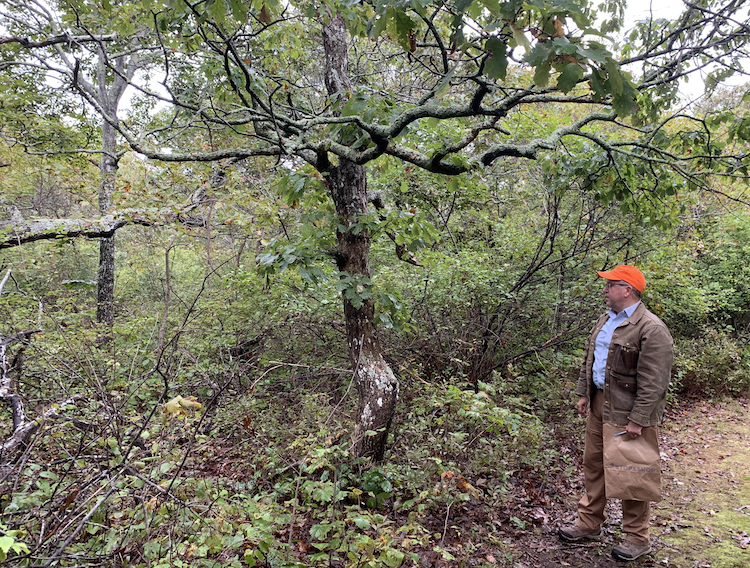Could this tree be a Quercus bicolor, a swamp white oak, growing here at Quansoo?
I had been pondering this tree for over a decade. Some years ago, on walking past the tree, I noticed that the leaves were a bit odd. They were crenate, which means that the leaves had wavy edges. The stem, however, looked just like that of any other white oak, Quercus alba, with ashen flaky bark. The tree was of some stature, reaching perhaps 25 feet high, which is tall for the weather-beaten picnic woods of Quansoo, and much taller than the dwarf chinquapin oak, Quercus prinoides, whose leaves bore a resemblance to those of this mystery plant.
 The leaves certainly looked like those of a swamp white oak. In fact, after photographing the leaves with my phone, my tree identification app told me that the tree was indeed a swamp white oak. If correct, this would be a botanical first for Martha’s Vineyard, as the swamp white oak has, so far, never been found on this island.
The leaves certainly looked like those of a swamp white oak. In fact, after photographing the leaves with my phone, my tree identification app told me that the tree was indeed a swamp white oak. If correct, this would be a botanical first for Martha’s Vineyard, as the swamp white oak has, so far, never been found on this island.
For ten years I thought about the possibility of the tree being a swamp white oak, but never pursued finding out. That changed this fall. The change was brought on by that most natural of human emotions: envy. I found myself quite envious of SMF botanists Liz Loucks and Kristen Geagan’s recent botanical finds.
In August, I sent Kristen out to Stonewall Pond Preserve in Chilmark to scout out a thicket of wetlands shrubs beside the shore of Stonewall Pond. She was not on a plant-finding expedition. Yet while bush-whacking through a tangle of bayberries and poison ivy and clethra, came across a beautiful flower, in a bloom of royal purple. This flower turned out to be the greater purple fringed bog orchid, Platanthera grandiflora, a native orchid, and one known from Martha’s Vineyard only from historical reports.

Spiranthes ochroleuca_
Then in September, while working in the meadows of Quansoo Farm, Liz noticed a bouquet of white flowers. Liz inspected the plant closely, took photos, and attempted to key the plant. This particular find turned out to be Spiranthes ochroleuca, yellow ladies’ tresses, another orchid. This diminutive and lovely orchid caught the attention of the State Botanist, as the plant identification was confirmed and proved to be a county record—a native plant never before identified in the County of Dukes County.
Inspired by, encouraged by, and envious of these discoveries, I resolved to determine whether my mysterious tree was indeed the swamp white oak. On a blustery October morning, I walked into the Quansoo woods with SMF newsletter editor Kate Feiffer and Liz Loucks to properly collect a botanical specimen for examination and identification.
I did have doubts. We had earlier consulted with Tim Boland, Executive Director of the Polly Hill Arboretum and an expert in oaks. Tim had noted that the acorns of the swamp white oak had long peduncles, meaning the acorns hung from long, slender stems. These acorns, however, were sessile, meaning that they sat directly upon the twig.
On reaching the tree, we cut a few branches from the tree with loppers. In a botanical press, we placed a twig bearing a few leaves on top of a section of newspaper, and then placed a section of newspaper atop it. On yellow paper, Liz wrote upon the sample “Adam Moore Number One,” referencing the first botanical sample that I had collected.
 We collected three samples, and strapped the presses tightly together. One sample was for the Polly Hill Arboretum, and two for the Arnold Arboretum at Harvard University. In a paper bag, we placed leaves, twigs, and acorns for Tim’s review.
We collected three samples, and strapped the presses tightly together. One sample was for the Polly Hill Arboretum, and two for the Arnold Arboretum at Harvard University. In a paper bag, we placed leaves, twigs, and acorns for Tim’s review.
I left the woods imagining myself as a botanist of yore, roaming the Appalachian mountains, collecting and discovering new species of trees as I traveled. Imagine the thrill of discovering a new, native tree for Martha’s Vineyard!
By noon, however, my hopes were utterly dashed. With his expert eye, Tim Boland identified the tree with certainty.
The tree was not swamp white oak, but rather was Quercus x faxonii, a hybrid of the white oak and the dwarf chinquapin oak. Though unusual, and seldom seen, the tree was just a hybrid, and not a new species to the island.
Though I have not yet found a “new” native tree species for Martha’s Vineyard, I resolve to keep at it.


